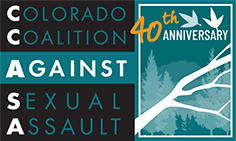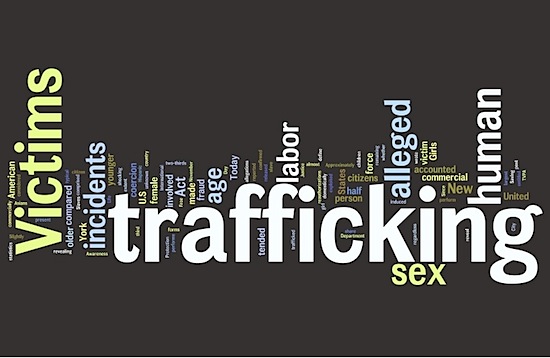By Becky Owens Bullard, CCASA Blogger
Over the past 6 years working in the anti-trafficking field, I’ve seen an enormous amount of positive growth in conjunction with many negative challenges. I’ve often attributed this to the anti-trafficking movement being in its “adolescence,” as it is technically much younger than the anti-sexual and domestic violence movements that began in the 1960s and 70s.
This so-called adolescence has its benefits: the anti-trafficking movement is energetic, optimistic, and very popular. Everyone seems to want to work on human trafficking, the news media consistently covers the topic, and donors are looking to fund anti-trafficking efforts. Additionally, passionate organizations and experts are doing ground-breaking work to combat trafficking. The field is understandably taking advantage of this energy and popularity by gaining some of the strongholds that the domestic violence and sexual assault movements were able to gain in the 80s and 90s – longer-standing organizations are solidifying their leadership, shelters are developing and programs expanding, and anti-trafficking laws are moving through political gridlock to assist survivors and hold exploiters accountable.
However, adolescence also has its “growing pains” and the anti-trafficking field can sometimes be just as erratic and impetuous as your average teenager. New organizations with little understanding of the crime seem to be forming every day; some even end up harming victims further. New individuals in the field may seem to claim expertise overnight, after seeing a movie or hearing a presentation on trafficking; some even falsify or elaborate on their credentials. Many of my colleagues in the sexual and domestic violence fields have told me they wouldn’t want to work in the anti-trafficking field for these reasons – because it can mean trying to reason with zealots who think they can “rescue” every victim or deal with individuals trying to “make a name” off of a new and burgeoning field.
Being the “popular kid” has its costs as well. When other anti-violence fields see that the anti-trafficking movement continues to garner the attention of news media and donors, it can feel incredibly discounting. When the crime of human trafficking is so often painted in the extreme as an issue “like no other,” it can feel extremely alienating. This frustration and alienation can be damaging, leading to a lack of collaboration and leaving other fields feeling like trafficking doesn’t intersect with the issues they work on. But for sexual and domestic violence organizations, we can’t walk away from working on human trafficking – both because the anti-trafficking field needs our voices and because it is without a doubt “our issue.”
Importance of the Intersections
In my capacity as a trainer on the intersections of human trafficking with sexual and domestic violence, I’ve also seen exciting growth and frustrating challenges in the sexual and domestic violence fields’ work on human trafficking. There has been amazing progress towards incorporating exploitation into sexual and domestic violence programs as well as tremendous leadership in these fields to be a part of, and even at the helm of, the anti-trafficking movement. However, I still frequently hear the sentiment that human trafficking just doesn’t fit squarely into these fields, making it more understandable why sexual and domestic violence agencies do not dive into anti-trafficking work.
For sexual assault agencies, sex trafficking typically feels like a natural fit into the parameters of working on sexual violence, whereas labor trafficking may not. I remember doing a training for a state coalition that asked specifically for the presentation to “stick to sex trafficking” and not go into labor, thinking that their member agencies wouldn’t have occasion to encounter these victims. However, when I asked the organizations what types of trafficking they had seen, many mentioned cases of individuals being sexually assaulted within situations of domestic servitude and agricultural labor.
For domestic violence agencies, finding parallels to this work may feel like an even bigger leap, especially with the way trafficking is often portrayed. The media and even anti-trafficking speakers typically highlight the more sensational stories of brutally violent “stranger-traffickers,” and rarely depict a trafficker as the husband selling his wife for sex or the father forcing his children to work. But as with many other crimes, traffickers can be those closest to their victims and exploitation can be a part of intimate partner violence and familial abuse.
The intersections are real and cases of human trafficking will fall into the laps of those working on sexual and domestic violence regularly. It may not be the primary case you see, but exploitative abuse is ever-present in your work, making it essential for you to be an integral part of the movement to combat trafficking.
On the other hand, even organizations that clearly see these intersections and want to be involved may not necessarily get invited to the anti-trafficking table as equal partners. At the first meeting of my organization, the Denver Anti-Trafficking Alliance, I asked how many of the 40-plus diverse agency partners in attendance had worked with a trafficking victim and almost all raised their hands. When I asked how many had attended a collaborative meeting on human trafficking, only a small number raised their hands. I also remember a state sexual and domestic violence coalition telling me that anti-trafficking organizations in their state used their member agencies when they needed shelter for a victim, but wouldn’t include them in funding or collaborative discussions. This lack of inclusiveness has underpinnings in some of the issues of adolescence mentioned above, and is a significant barrier to providing a comprehensive response to human trafficking.
Crucial Voices in the Field
While the anti-trafficking movement may not be actively seeking sexual and domestic violence organizations’ participation, your voice is critical to anti-trafficking work. As mentioned before, being in its adolescence means the anti-trafficking field has several energetic, amazing organizations and experts doing exceptional work; however, the field is also vulnerable to inexperienced organizations and self-proclaimed “experts” that can do serious harm to victims and survivors. Sexual and domestic violence organizations can help prevent this harm by bringing a time-tested, trauma-informed perspective to the anti-trafficking table. This perspective and the non-harmful services available to victims through sexual and domestic violence agencies are essential to support the anti-trafficking movement where true expert voices may be in the minority.
At this point, let me be clear (because I can visualize some people getting worked up about now), I am not asking you to drop your work on sexual and domestic violence and become an anti-trafficking “only” organization or to take on “one more thing” with no funding behind it. I am asking you to recognize human trafficking as part of your existing work on abuse. Because, let’s be honest, you are already doing the work. If a man is sexually assaulted by his employer who is also trafficking him, your organization will serve him if you can because he is a victim of sexual violence. If a woman is sold for sex by her husband to “make ends meet,” you will serve her if you can because she is a victim of sexual and domestic violence. Right?
Call to Action
So now is the time to claim your seat at the anti-trafficking table and to add your voice to those of anti-trafficking advocates working to help the movement mature past its adolescence. By doing this, your organization can provide services to trafficking survivors that are time-tested and trauma-informed, take part in collaborative funding opportunities to support those services, and vet agencies and individuals whose experience may be lacking and ultimately harmful to survivors.
Your voice is not only important because the sexual and domestic violence movements are technically in their “adulthood” and have a seasoned perspective of trauma-informed service and collaborative work— it is also critical to this work because human trafficking is, without question, your issue too.
Image credit:

